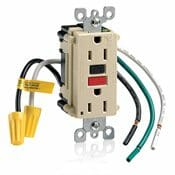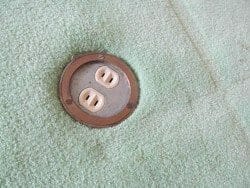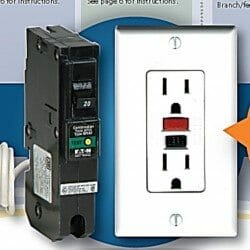GFCI Outlets And Where They Are Required
Home » Electrical » Outlets & GFCI »

Lifesavers
GFCI outlets, technically called GFCI receptacles, save lives.
GFCI stands for “ground fault circuit interrupter”, sometimes called a GFI. Its purpose is to help protect users against electrical shock.
If you’re in the bathroom and you put your hand accidentally down in a sink filled with water while holding a plugged-in hairdryer; it may shock or electrocute you if the outlet is not GFCI protected. The same is true in the kitchen, if you were holding an electric device and you accidentally put your hand in the sink with water while holding the device, it might shock, kill or injure you.
Where do you put GFCI’s
Recommended locations:
- Outdoors, patios, porches, fountain areas (since 1973)
- Bathrooms (since 1975)
- Garages, carports (since 1978)
- Spas (since 1981)
- Kitchens, cooking areas (since 1987)
- Crawl spaces and unfinished basements (since 1990)
- Wet bar sinks (since 1993)
- Laundry rooms and utility sinks (since 2005)
Local building departments
Remodeling – when an outlet, in any location where it may encounter water or dampness, is replaced or added in an existing home; then it is recommended to be GFCI protected.
Kitchen has been remodeled? – then it should have GFCI protection
Bathroom has been remodeled? – then it should have GFCI protection
My house is an older house and there is no ground wire. Can I still use a GFCI and will it work?
Yes. A non-grounding type receptacle may be replaced with a grounding-type GFCI receptacle without a grounding wire connection and it will provide GFCI protection.
Don’t confuse GFCI outlets with AFCI outlets
Now the building codes and building jurisdictions are requiring AFCI to be put in certain locations in a home built today. At times a contractor may use an AFCI outlet or he may use an AFCI breaker. READ MORE ABOUT AFCI’S




An outlet was replaced in my kitchen and when it was screwed into the box, the ground wire touched the hot wires of the circuits which caused a spark and tripped the breaker when power back up. There was light scorching on the side of the outlet and underside of outlet cover plate. The ground wire was then moved safely away and the outlet worked properly afterwards. Is it safe to continue using that outlet that briefly arced or should it be replaced with another brand new one. Could damage to the wires have occurred?